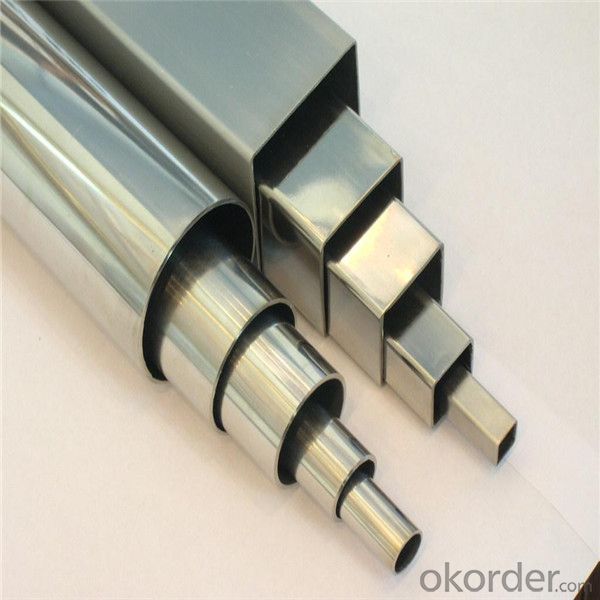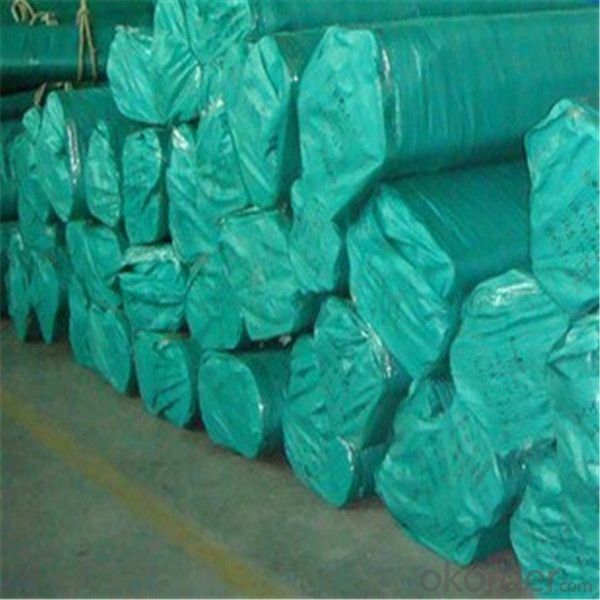SS 316 stainless steel round pipe price list
- Loading Port:
- Shanghai
- Payment Terms:
- TT OR LC
- Min Order Qty:
- 5 m.t.
- Supply Capability:
- 3800 m.t./month
OKorder Service Pledge
OKorder Financial Service
You Might Also Like
Item specifice
Specification
High quality 304,316 stainlesss steel bar square & round in stock
1.Competitive price and quality
2.Delivery fast
3. Material grade: 201,202,304,316,316L,430
4. Main material:
a) 201 (Ni0.8%-1%)
b) 202 (Ni: 3.0%-4.0%)
c) 304 (Ni: 8% Cr: 18%)
d) 316 (Ni: 10% Cr: 18%)
Outer diameter:5mm-550mm or as your requirement
Length: 6m or as your requirement
Surface:Bright, Polished, Turn smooth(Peeled),Brush, Mill,Pickled
Chemical Composition
Material
Composition | 201 | 202 | 304 | 316L | 430 |
C | ≤0.15 | ≤0.15 | ≤0.08 | ≤0.035 | ≤0.12 |
Si | ≤1.00 | ≤1.00 | ≤1.00 | ≤1.00 | ≤1.00 |
Mn | 5.5-7.5 | 7.5-10 | ≤2.00 | ≤2.00 | ≤1.00 |
P | ≤0.06 | ≤0.06 | ≤0.045 | ≤0.045 | ≤0.040 |
S | ≤0.03 | ≤0.03 | ≤0.030 | ≤0.030 | ≤0.030 |
Cr | 13-15 | 14-17 | 18-20 | 16-18 | 16-18 |
Ni | 0.7-1.1 | 3.5-4.5 | 8-10.5 | 10-14 | |
Mo | 2.0-3.0 |


Application
Widely used in petroleum, Foodstuff, chemical industry, construction, electric power,
nuclear energy, biotechnology, machinery, papermaking, shipbuilding, boiler fields etc.
Maintentance
(1) Regular cleaning and maintenance
(2) Pay attention to prevent the occurrence of the phenomenon of surface scratches
(3) Use soap, weak detergent or warm water to remove surface dust, dirt
(4) In addition to the surface of the binder with alcohol or an organic solvent (ether, benzene)
(5) Use neutral detergent or ammonia solution in addition to surface oil
(6) With 10% nitric acid or abrasive detergent in addition to the surface of the embroider
caused by the dirt
Packaging & Delivery
In bundle or as per customer’s requirements
30 days after receipt the 30% downpayment or draft of irrevocable L/C at sight

We offering:
Quality Products
More Competitive Prices
Fast Delivery
Quick Reply
Sincere Service
Featured products:
Alloy steel: Combination of steel / Bearing steel// Spring steel/ Cr- mo steel
GB 20Cr/ 40Cr / 42CrMo / 35CrMo/ 20CrMn/GCr15/30CrMnTi…
ASTM 5120 /5140 / 4140/ 4135/ 5152/52100…
JIS SCr420H/ SCr440/ SCM3/ SUP9/SUJ2…
Carbon steel: Carbon tool steel /Carbon Structural Steel
GB 20/ 35 /45/…
ASTM 1020/ 1030/1045…
JIS S20C/ S30C / S45C…
Products Show
- Q:How do you measure the thickness of a stainless steel pipe?
- To measure the thickness of a stainless steel pipe, you can use a few different methods depending on the available tools and the accuracy required. One common method is to use a caliper or micrometer, which are precision measuring instruments. By opening the caliper and placing one jaw on the outside surface of the pipe and the other jaw on the inside surface, you can measure the distance between the jaws. This measurement will give you the thickness of the pipe. Another method is to use an ultrasonic thickness gauge. This device emits high-frequency sound waves that travel through the pipe and bounce back from the inner wall. By measuring the time it takes for the sound waves to travel and return, the gauge can calculate the thickness of the pipe. For larger pipes or when more accuracy is required, you can also use a laser-based method. Laser-based devices use a laser beam to scan the surface of the pipe and measure the distance from the beam to the surface. By scanning along the circumference of the pipe, you can obtain multiple measurements that can be averaged to determine the thickness. It is important to note that before measuring the thickness, you should ensure that the surface of the pipe is clean and free from any debris or coatings that could affect the accuracy of the measurements. Additionally, it is advisable to take multiple measurements at different points along the length of the pipe to account for any variations in thickness.
- Q:What is the difference between 2205 and 316 stainless steel pipes?
- The main difference between 2205 and 316 stainless steel pipes lies in their composition and properties. 2205 stainless steel is a duplex stainless steel, meaning it consists of both austenitic and ferritic phases. This makes it highly resistant to corrosion and provides excellent strength and toughness. It has a higher yield strength compared to 316 stainless steel, making it suitable for applications where higher strength is required, such as in the oil and gas industry. On the other hand, 316 stainless steel is an austenitic stainless steel, known for its corrosion resistance and excellent weldability. It contains higher amounts of chromium and nickel, providing better resistance to chloride corrosion and acid attacks, making it commonly used in marine and chemical environments. In summary, 2205 stainless steel is preferred when higher strength and resistance to corrosion and stress corrosion cracking are essential, while 316 stainless steel is chosen for its superior corrosion resistance in chloride-rich environments.
- Q:Are stainless steel pipes recyclable?
- Yes, stainless steel pipes are recyclable. Stainless steel is a highly sustainable material that can be recycled repeatedly without losing its properties or quality. Recycling stainless steel pipes helps conserve resources, reduce waste, and minimize environmental impact.
- Q:What is the difference between 316 and 316L stainless steel pipes?
- The main difference between 316 and 316L stainless steel pipes is the carbon content. 316L has a lower carbon content, making it more resistant to corrosion and suitable for applications where welding is required. It also has a higher creep, stress-to-rupture, and tensile strength, making it a preferred choice in high-temperature environments.
- Q:Can stainless steel pipes be used for oil pipelines?
- Yes, stainless steel pipes can be used for oil pipelines. Stainless steel is known for its high corrosion resistance, making it suitable for transporting various fluids, including oil. It is also durable and can withstand high pressure and temperature conditions, making it an ideal choice for oil pipelines. Additionally, stainless steel pipes have a smooth interior surface, which helps in reducing friction and improving the flow of oil. However, the selection of stainless steel grade and proper coating should be considered to ensure the pipes' compatibility with the specific type of oil and the environmental conditions in which they will be used.
- Q:Can stainless steel pipes be used for dairy processing equipment?
- Yes, stainless steel pipes can be used for dairy processing equipment. Stainless steel is a popular choice in the food and beverage industry due to its excellent corrosion resistance, hygienic properties, and durability. It is resistant to rust, staining, and contamination, making it ideal for use in dairy processing equipment where cleanliness and food safety are paramount. Additionally, stainless steel pipes can withstand high temperatures and pressure, which are often required in dairy processing operations. Overall, stainless steel pipes are a reliable and suitable material for use in dairy processing equipment.
- Q:Are stainless steel pipes more expensive than other types of pipes?
- Yes, stainless steel pipes tend to be more expensive than other types of pipes due to their durability, corrosion resistance, and high-quality material.
- Q:What is the density of stainless steel pipes?
- The density of stainless steel pipes typically ranges from 7.9 to 8.0 grams per cubic centimeter.
- Q:Are stainless steel pipes suitable for paper mills?
- Paper mills benefit greatly from the use of stainless steel pipes due to their suitability for the harsh conditions found in these facilities. With constant exposure to water, chemicals, and high temperatures, stainless steel pipes offer long-lasting durability. Their resistance to rust and corrosion ensures the integrity of the pipes, preventing leaks or contamination in the paper production process. Furthermore, stainless steel pipes are easy to clean and maintain, crucial for maintaining cleanliness and hygiene in paper mills. The smooth surface of these pipes prevents debris buildup, reducing the risk of blockages and improving material flow. In addition to their resistance to corrosion, stainless steel pipes are also strong and capable of withstanding high temperatures. This makes them ideal for the extreme conditions present in paper mills, where hot water, steam, and chemicals are frequently used. Overall, stainless steel pipes are an excellent choice for paper mills due to their corrosion resistance, cleanliness, durability, and high-temperature resistance. Their use contributes to efficient and reliable paper production processes.
- Q:Stainless steel pipes can not be less than the amount of chromium
- The chromium content of stainless steel is generally not less than said first why stainless steel tube is not easy to rust 12%-304 stainless steel tube, then why stainless steel will rust stainless steel is not easy to have a great relationship with the composition of stainless steel rust. In addition to iron, stainless steel contains chromium, nickel, aluminum, silicon and so on.
1. Manufacturer Overview |
|
|---|---|
| Location | |
| Year Established | |
| Annual Output Value | |
| Main Markets | |
| Company Certifications | |
2. Manufacturer Certificates |
|
|---|---|
| a) Certification Name | |
| Range | |
| Reference | |
| Validity Period | |
3. Manufacturer Capability |
|
|---|---|
| a)Trade Capacity | |
| Nearest Port | |
| Export Percentage | |
| No.of Employees in Trade Department | |
| Language Spoken: | |
| b)Factory Information | |
| Factory Size: | |
| No. of Production Lines | |
| Contract Manufacturing | |
| Product Price Range | |
Send your message to us
SS 316 stainless steel round pipe price list
- Loading Port:
- Shanghai
- Payment Terms:
- TT OR LC
- Min Order Qty:
- 5 m.t.
- Supply Capability:
- 3800 m.t./month
OKorder Service Pledge
OKorder Financial Service
Similar products
New products
Hot products
Hot Searches
Related keywords



























